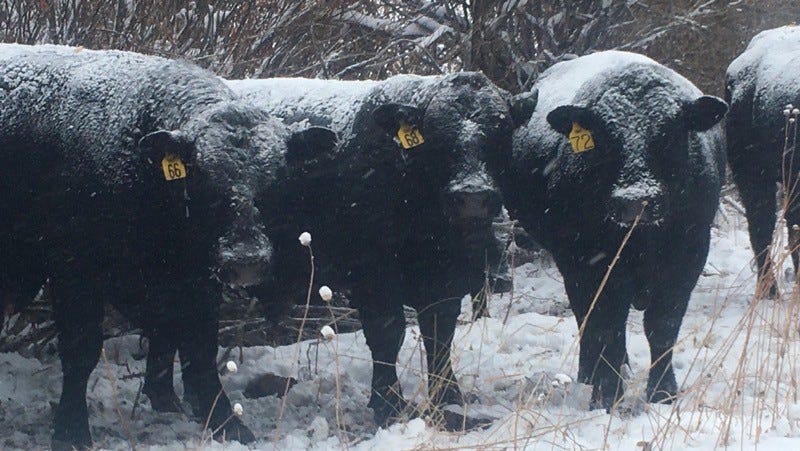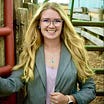Albany County farmers, ranchers reflect on changing industry
The Laramie Reporter spoke with Albany County’s agriculturalists about the modern business of growing hay and raising cows.
Ranching or farming at 7,200 feet, Albany County agriculturists face unique challenges. And like agriculturists everywhere, they find themselves in a changing industry.
According to the 2020 U.S. Census, 1.37% of the U.S. population works in agriculture, forestry and fishing. But in Wyoming, agriculture is the state’s third largest sector (after minerals and tourism), according to USDA statistics.
Albany County’s agriculturists are a diverse bunch. They range from first-time farmers starting their own operation to second- and third-generation owners and operators. Most are completely focused on their beef or hay production outfit, but some work side jobs.

Members of the Albany County Stockgrowers Association said they face rising costs of production — from land and lease costs, fuel, water and even simple veterinary care. They shared hope for the next generation, and expressed that technology keeps advancing, making life a little easier than it used to be.
The Laramie Reporter caught up with two Albany County agriculturists to chat about the challenges and rewards of their changing profession.
Jim Rogers, Browns Creek Ranch
Jim Rogers has owned his ranch for 28 years, where he started running cow-calf pairs, building from 200- to 600-head. He later sold his cows and switched to running a yearling operation, bringing in other people’s yearling cattle and letting them graze his pastures. With 1,200 acres of hay meadows the yearlings are rotated during the grazing period to prevent the ground from becoming over-grazed.
“It’s so hard now to get started, I was fortunate enough to be in an era where I could buy a small ranch in Pinedale — where we were for 13 years,” Rogers said. “We were able to buy some land up in the mountains and turn around and sell the place in Pinedale. The sad thing for young people now: they just can’t compete unless they have something to work with — from interest rates to the amount of money it costs to do it.”
Rogers shared his plans to pay off a small loan he acquired to purchase the ranch. He planned to do so by building up his cow herd, but did not plan on a drought that occurred in 2002. Rogers also said the only way to really make money off land is to move it, selling and buying.
Rogers’ family was able to buy a small place that joined his, which had a house they could convert to an Airbnb. They continue to plan for a different income source for the future.
“We’ve got this great asset but we have to look at it as, ‘how can it generate us more money?’ Money isn’t everything but we can’t do much without it either,” Rogers said. “So, we are in the process of building some cabins by the creek and we will then build a wedding venue. The amount of land that we took out of use will not affect our operation but I think it will generate some income.”
He said when one door closes, another will open, you just might have to wait in the hall for a while. Having a good attitude and being willing to work hard helps open more doors for you. Rogers said he believes you make your own opportunities in life — that you can’t wait for the chance to come to you.
Shanon Sims, Sims Cattle Company, LLC
Shanon Sims and his family run around 650 head of cow-calf pairs and 300 head of yearlings which generally consists of the heifers kept back to replace cows out of their herd. The focal point for their operation is providing seed-stock for other operations.
“Part of our mission is to produce livestock adapted to our climate. Our climate is very unique — 7,200-feet elevation, 45-60 day grazing period and like 13 months of winter,” Sims said. “There is not a lot of growing season, so it takes a special kind of animal to survive here. So, rather than trying to source genetics from elsewhere, we made the decision to close our herd and raise our own bulls, heifers and cows. The outcome of that has been other people becoming interested in our genetics. And we can only use our bulls so much, so when they aren’t working for us, we lease them to other people.”
Sims plans to raise and keep more bulls and heifers back to sell private-treaty to other producers. He said every option is available and open until it is discussed and closed. So he keeps an open mind about niche markets and other opportunities that fit within their operation lines.
Their operation looks mostly at maternal needs, and cows are rotated on pastures quickly. During their growing period, cows are rotated every three days; once fall and winter come, the cows are rotated every ten.
“I don't want to take anything away from the lifestyle — but in order to live that lifestyle, operations have to be profitable,” Sims said. “The business has changed a lot — when diesel fuel was cents per gallon instead of dollars per gallon, the same things just don’t work anymore. So, our focus is more about being able to adapt our model continuously.”
Sims and his family focus on creating holistic goals, which has allowed them to stay flexible through many changes in life. They are part of the Ranching for Profit School and Executive Link, which have helped them realize who they needed to market to.
The numbers
The beef cow population (meaning females that have calved) for the state of Wyoming sat around 681,000 as of Jan. 2022, according to the USDA. Dairy populations are around 9,000, INCL calves (just weaned for slaughter or development purposes) sit around 1,250,000, and there were another recorded 69,000 head of cattle on feed.
In other words, there are more beef cows than human residents of Wyoming and twice as many INCL calves as people. There are also more head of cattle on feed than there are residents of the state’s capital city.
Hay production also made its way to the top of the USDA’s breakdown for the state. Hay and haylage (hay products made into silage) were noted to be worth $395,458,000 in value of production dollars.





